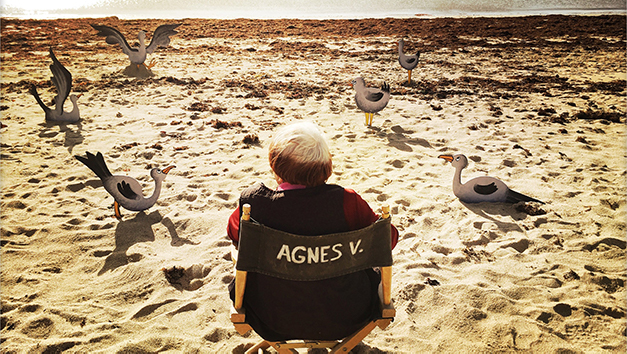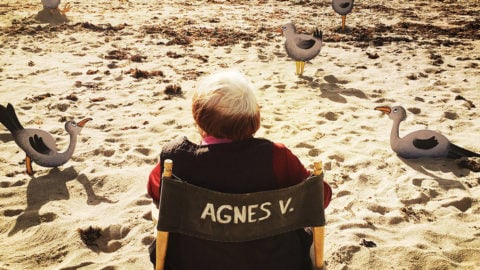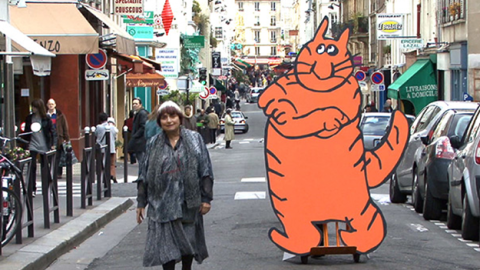Film of the Week: Varda par Agnès

Varda par Agnès (Agnès Varda, 2019)
Varda par Agnès ends quietly, with the image of Agnès Varda and her photographer sidekick JR engulfed by a gentle sandstorm. “Disappearing in a blur, I leave you,” Varda says. These final moments, restating a theme of her last film, 2017’s JR collaboration Faces Places, make it clear that the “blur” engulfing Varda is as much as anything a sight problem: again, she shows us that film’s image of people holding up giant letters in comic imitation of an optician’s eye test. This is one of the key oppositions in Varda’s career: the blur to which the confusion of modern life subjects us versus the clarity that comes with an artist’s willingness to look at things up close, with tender, respectful attention. Varda has done the latter throughout her career, in documentary and in fiction, and an emblematic example of it is shown here: the extreme close-up images of the hair and skin of her late husband, filmmaker Jacques Demy, shortly before he died.
Varda par Agnès isn’t exactly a self-portrait—Varda has already made one, her 2008 memoir film The Beaches of Agnès. Rather, her new film—which premiered out of competition this week in Berlin—is a pendant or postscript to that film, a set of discursive and contemplative footnotes to her work in general, as filmmaker, still photographer, installation artist. It’s presented as a discontinuous master class, beginning with Varda sitting on stage addressing the first of a series of audiences in different venues, sometimes joined in casual conversation with various collaborators such as DP and filmmaker Nurith Aviv (although Varda reserves the right to do most of the talking).
This film won’t feel unfamiliar to anyone who’s either heard Varda in person, or seen The Beaches of Agnès. It fairly comprehensively recycles both that work and all the films that it drew on—but then, recycling has been Varda’s key method since the start of this century. She rebooted her career in 2000 by discovering the DV camera; she used it to make The Gleaners and I, a film about people who “glean” or forage for a living, or for art. In it, Varda declared herself too to be a gleaner—someone who gleaned images from the world around her and who also recycled existing material. She certainly did the latter in The Beaches, making a collage of her work and personal history, but she also did it literally in the series of “shacks” she built in her new career as a visual artist (a term she refers to by the usual French plasticien: “We don’t make plastic”). Her first shack was a cabin made literally from film, its walls and roof woven out of repurposed celluloid from a print of her 1965 feature Le Bonheur (meaning “happiness”).
Happiness has long been a motivating factor of Varda’s work. Her recent creations have been impish, even facetious, in a way that might easily be regarded as kitsch or simply first-generation hippie-ish, if not that Varda got away with it by presenting herself in such engagingly playful terms: what other filmmaker, of any age, would have turned up at their own Venice Biennale installation dressed as a potato?
Varda talks at the start of the film about three key principles of her conception of art: inspiration, creation, and sharing. “You,” she tells her audience, “are the living proof of this sharing.” That sharing—the communitarian aspect of her work—emerged in Faces Places, a collaboration not just with JR but, properly speaking, with all the everyday French citizens who lent their faces, and their voices, to this epic but intimate photographic project. That Varda’s work has always been democratic—about the people and places around her, rather than an artist’s privileged act of seeing and presenting them—emerges in documentaries such as Daguerreotypes (1975), a close look at the apparent (but only apparent) mundanity of Paris’s rue Daguerre, where Varda has lived since the ’50s. It’s also there in her early Paris documentary, the 1958 short L’Opéra-mouffe, about rue Mouffetard, where, as she says, the Middle Ages still shows its traces. Here, postwar Paris seems to retain centuries’ worth of deprivation and sorrow: its gallery of harshly treated physiognomies, ravaged by age and disappointment, Varda points out, collects the faces of people who were once newborns.
Varda has a way of being jokey to illustrate a serious point: she and her one-time star Sandrine Bonnaire perch with umbrellas on a dolly being trundled through the rain, to illustrate the way that their 1985 film Vagabond (Sans toit ni loi) was composed of 13 tracking shots, from right to left. Some of her films do use the traditional machinery of industrial cinema, whether it’s dollies or name actors, like the ridiculously lavish pantheon (Piccoli, Deneuve, Depardieu, Delon, De Niro) that appeared in her centenary-of-cinema fantasy A Hundred and One Nights—a commercial flop, Varda cheerfully notifies us. But in general, her work is pragmatic, off-the-cuff, as dynamically reactive to the world around her as any filmmaker’s work, experimental or otherwise, has ever been. “Film quickly, with the means at hand,” she says. The first illustration in Varda par Agnès is taken from 1967 docu-portrait Uncle Yanco, about a relative that Varda happened to discover in Sausalito, only a day and a half before she shot the film. Her and Yanco’s first greeting is staged and restaged, cut for maximum comic and rhythmic repetition, and given an extra theatrical twist by the colors: his bright pink jumper, her purple regalia (it was the Californian ’60s, after all).
The impromptu emerges even more strongly in a hybrid of documentary and autobiographical fiction, 1981’s Documenteur (the title puns on menteur, “liar”). There are images in this feature that are mysterious, and that stamp yourselves on your imagination, because they just happened to be there, living objets trouvés that puzzled and delighted the filmmaker. A woman on a beach pretending to be dead, flanked by two men—just there. A woman in a laundromat, obsessively playing with her long hair—just there (but her movements transformed by the attention of the camera behind her, and by Georges Delerue’s music). A similar dimension of happenstance discovery came while making 1988’s Jane B. by Agnès V., a portrait of Jane Birkin at 40. While they were filming, Birkin told Varda her idea for a story about a woman who falls in love with a boy who’s in love with a computer game. They broke off the project on the spot to shoot the story as a feature, Kung Fu Master, starring Birkin and Varda’s son Mathieu Demy, over the latter’s school holidays. When term started, work resumed on Jane B.
One of Varda’s recent substantial achievements is another portrait work, The Widows of Noirmoutier—a video project in which Varda gives voice to women from the island of Noirmoutier in north-eastern France, which has been her holiday home for years. It’s a portrait of widowhood by a widow, an act of solidarity and oblique self-portraiture. The piece is a commentary on memory, mortality, and loss, and part of a larger installation project inspired by Noirmoutier, including the beach’s electrically hued summer frivolities (plastic flip-flops, balls, swimming floats, et al), that Varda first mounted at Paris’s Fondation Cartier in 2006. The inclusion of the melancholy The Widows makes that overall show, as Varda says about her deceptively lush-colored but ultimately melancholic Le Bonheur, “a beautiful summer peach, but with a worm inside.”
Over six decades—at least since 1962’s ground-breaking feature Cléo from 5 to 7—Varda has been acclaimed as a pioneer of modern feminist cinema. But as she has moved through recent years, she has become something differently radical, and perhaps unequalled in cinema—a flag-bearer for self-reinvention and self-revitalization. First with The Gleaners and I, then her out-of-the-blue transformation into an installation artist, she is living proof that new careers, new practices, new visions can be undertaken by people in their seventies, and beyond. Given that Varda is now 90, her closing words in Varda par Agnès—“Disappearing in a blur, I leave you”—sound valedictory in a definitive sense, although you can’t really see her ever fading out in a blur. The gods of cinema willing, you can easily imagine her carrying well on, indefatigably and impishly, into the next decade—breaking Manoel de Oliveira’s record, and doing it in a silver-and-plum-pudding bowl hairdo.
Jonathan Romney is a contributing editor to Film Comment and writes its Film of the Week column. He is a member of the London Film Critics Circle.





